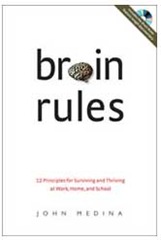>
John Medina’s Brain Rules is a fascinating book. Medina has taken the complicated brain and made it understandable and interesting with an engaging narrative. The book contains “12 Principles for Surviving and Thriving at Work, Home, and School”
I bought it because Garr Reynolds on Presentation Zen said that Brain Rules would improve my presentations. He was right. What caught me by surprise was that Brain Rules contains powerful marketing rules. Medina didn’t write the book for marketers, but it is a treasure trove of marketing insight. In my previous post, I presented the first four rules. Here are the remaining marketing rules I harvested from Brain Rules:
Rule #5 – Use Frequency To Help People Remember
I recently made the case for frequency on Drew’s Marketing Minute. Frequency is the number of times an individual comes in contact with your marketing message. Frequency is critically important if there is no immediate need for your product. The reason: people forget. The majority of forgetting occurs in the first few hours of learning. In fact people forget 90% of what they learn within 30 days.
The solution to the forgetting problem is frequency. You can increase the life span of your message simply by repeating information in timed intervals. Medina says that “Spaced learning is greatly to superior to mass learning.” And the space between repetitions is a critical component for transforming temporary memory into a more persistent form.
Consistent repetition will create a more durable memory of your message. “Repeated exposure to information in specifically timed intervals provides the most powerful way to fix memory in the brain.” When you promote your business, you should do so with a consistent schedule and you should go no longer than 30 days without exposure.
Rule #6 – Elaborate Messages Are Stronger
Elaboration combined with frequency is a powerful memory cocktail. Extra information given at the moment of learning makes learning better. If you want people to remember you, help them remember you elaborately. This does not mean adding more detail and complexity (Rule #4). Stories and perfume are the best illustrators of this rule.
Using stories in marketing makes a message stronger. Stories provide elaborate details of your message without adding complexity. Details in stories are like little pieces of memory glue that bind the main point of the story into your brain archives. Likewise with perfume. A special date is made more memorable when your partner wears an alluring fragrance. Engaging the senses provides elaboration to the memory.
Medina says that “Extra information given at the moment of learning makes learning better.” and that “multi-sensory experiences are more elaborate.” Look for stories to combine with the key idea of your marketing message. Then engage as many senses as you can in your stories because multi-sensory experiences are more elaborate.
Rule #7 – Stimulate the Senses in Your Customer Experience
Stimulate more of the senses at the same time to maximize your customer’s experience. Our senses do not operate independently of each other. Medina says “that sensory processes are wired to work together,” integrating all sensory information into one experience. The more senses you involve for your customer, the greater the experience.
Visual sensory inputs influence auditory inputs. Visual senses are boosted by introducing touch. Multiple senses affect our ability to detect stimuli using the brain’s powerful integrative instincts. The effect is called ‘multimodal reinforcement.’
Multi-sensory environments are better than uni-sensory environments because they yield a more accurate recall. Medina says that in these environments (think: customer experience) “recall has better resolution and lasts longer.” Use multiple sensory cues in your customer’s experience to enhance the impact.
Rule #8 – Visual Marketing is Strongest
Vision dominates all other senses. In fact, the brain uses half of its resources on vision alone. Medina says “vision is probably the best single tool we have for learning anything.” If information is presented orally, people remember about 10%, but add a picture and that figure jumps to 65%. Pictures transfer information.
Medina also says this: “pictorial information (is) superior in capturing attention – independent of its size.” And then Medina drops the marketing bomb: “Because (vision) is also a more efficient way to glue information to a neuron, there may be strong reasons for entire marketing departments to think seriously about making pictorial presentations their primary way of transferring information.”
So what kind of visulas work best? Brains pay lots of attention to color, orientation, size and motion. However, the brain does not like complexity in its visuals. The rule then is to use simple, colorful visuals in context with motion.
A Marketing Gold Mine
I’m on record as saying that every marketer and business owner should read Brain Rules. It’s one of those books that combines all your previous marketing knowledge into a unique and insightful marketing perspective. It’s a book that turns on the proverbial light bulb.
See also: Brain Rules For Marketing – Part 1
For more on Brain Rules see the website:
Brain Rules: 12 Principles for Surviving and Thriving at Work, Home, and School
Let future articles from The Marketing Spot come to you: Receive by Email or


![Reblog this post [with Zemanta]](http://img.zemanta.com/reblog_e.png?x-id=00716cc5-bd04-4baa-b066-256ec95a74c0)

[…] frequently. I’ve written before on the importance of frequency, and even included it in my Brain Rules for Marketing. But frequency is not easy to achieve without […]